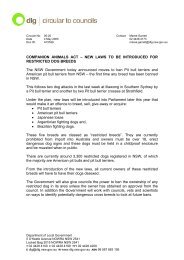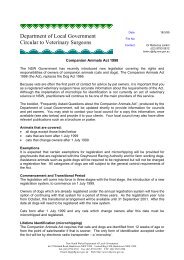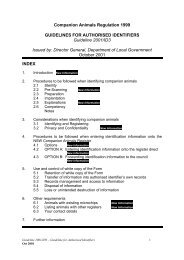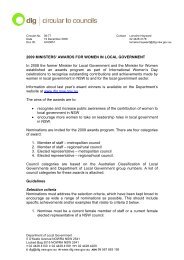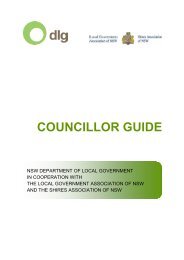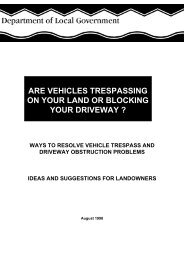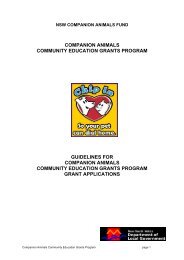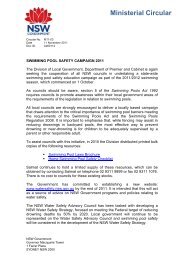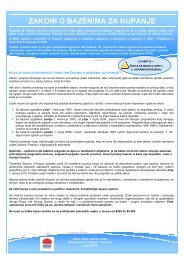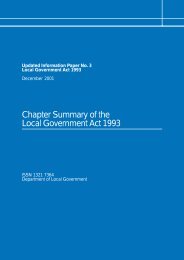Integrated Planning and Reporting Manual - Division of Local ...
Integrated Planning and Reporting Manual - Division of Local ...
Integrated Planning and Reporting Manual - Division of Local ...
Create successful ePaper yourself
Turn your PDF publications into a flip-book with our unique Google optimized e-Paper software.
2. THE COMMUNITY STRATEGIC PLAN<br />
The diagram following shows the main stages <strong>of</strong> the engagement process:<br />
Stage One<br />
Preparing information<br />
Stage Two<br />
Developing the Draft<br />
Community Strategic<br />
Plan<br />
Stage Three<br />
Reviewing the Draft<br />
Community Strategic<br />
Plan, Resourcing<br />
Strategy & Delivery<br />
Program<br />
Stage Four<br />
Reviewing the<br />
Community Strategic<br />
Plan at the end <strong>of</strong> each<br />
Council term<br />
Target discussions with<br />
particular groups, State<br />
agencies etc to help<br />
prepare discussion<br />
papers or ‘State <strong>of</strong> the<br />
Shire’ information, that<br />
will inform the<br />
Community Strategic<br />
Plan.<br />
These discussions may<br />
also identify relevant<br />
regional strategies or<br />
plans from other<br />
agencies <strong>and</strong> groups.<br />
Council may also seek to<br />
obtain feedback from<br />
particular stakeholders<br />
on the effectiveness <strong>of</strong><br />
previous plans or<br />
strategies.<br />
A series <strong>of</strong> engagement<br />
activities based on the<br />
discussion papers/<br />
reports prepared in Stage<br />
One.<br />
This will be the most<br />
resource intensive stage,<br />
involving a range <strong>of</strong><br />
activities for different<br />
groups, at different times.<br />
Discussions on levels <strong>of</strong><br />
service <strong>and</strong> possible<br />
resourcing levels will be<br />
held at this stage.<br />
The aim is to prepare a<br />
Draft Community<br />
Strategic Plan.<br />
This is the stage where<br />
the community will refine<br />
the Community Strategic<br />
Plan <strong>and</strong> consider<br />
Council’s response to the<br />
Community Strategic<br />
Plan via the Delivery<br />
Program.<br />
Council will need to plan<br />
for broad-range<br />
information sessions to<br />
ensure as many<br />
community members as<br />
possible are aware <strong>of</strong> the<br />
draft Community<br />
Strategic Plan <strong>and</strong> the<br />
Delivery Program.<br />
Use <strong>of</strong> targetted<br />
discussions or focus<br />
groups may also be<br />
appropriate.<br />
When there is a review <strong>of</strong><br />
the Community Strategic<br />
Plan, the community gets<br />
an opportunity to review<br />
Council’s performance in<br />
achieving the objectives<br />
in the Community<br />
Strategic Plan, <strong>and</strong><br />
provide feedback on their<br />
appropriateness.<br />
It also provides an<br />
opportunity for the<br />
community to identify<br />
new issues to be<br />
included as the plan is<br />
rolled forward.<br />
There is no st<strong>and</strong>ard format for the Community Engagement Strategy. It is up to each council to<br />
decide how the Strategy will be developed <strong>and</strong> implemented.<br />
When developing the Strategy, Council should consider the various reasons why community<br />
members may wish to be involved in the planning process. For example:<br />
some people will have ‘place-based’ interests – they are concerned for the future <strong>of</strong> their<br />
particular town, village or suburb<br />
some will share a common interest, such as a business group, or a sporting organisation<br />
others will share common needs, for example people who need child care or public transport<br />
some will be motivated by negative experiences with Council or community organisations<br />
<strong>and</strong> will want to address specific issues<br />
some will be motivated by philosophical commitments, for example, to sustainability or good<br />
governance.<br />
Council should consider all these motivations when identifying stakeholders <strong>and</strong> determining how<br />
<strong>and</strong> when they may best be engaged in the planning process.<br />
<strong>Planning</strong> & <strong>Reporting</strong> <strong>Manual</strong> Page 39 <strong>of</strong> 115





